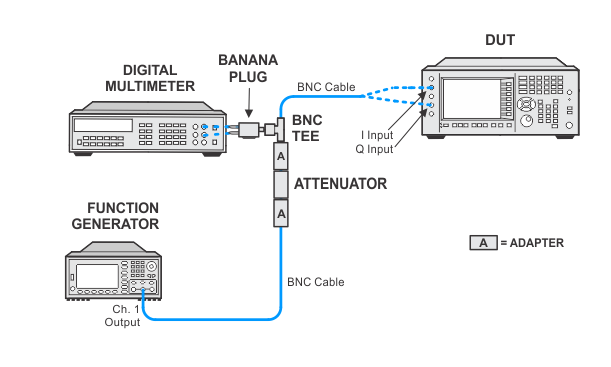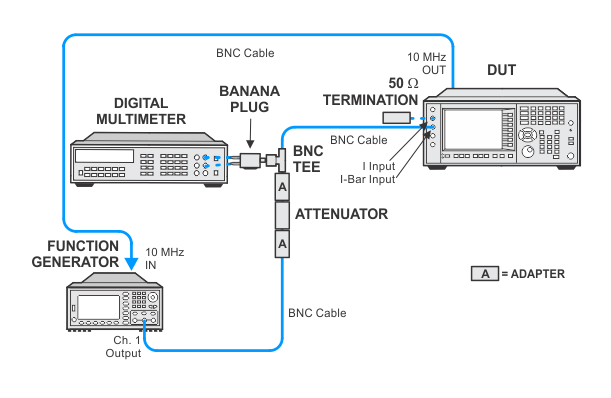
In the following setups, cables are designated as solid lines and direct connections are designated as dashed lines.
PXA — N9030A/B
The Baseband IQ (BBIQ) hardware is a separate measurement path from the signal analyzer RF path. The BBIQ path is controlled through the IQ Analyzer Mode. The BBIQ hardware has four different input ports (or channels):
|
|
|
|
Each input port has 4 different amplitude ranges:
|
|
|
|
Each input has two impedance choices: 50 Ohm and 1 Meg Ohm. There are potentially 32 different Input/Range/Impedance test variants that need to be tested.
Baseband IQ Absolute Amplitude Accuracy is nominally defined at 250 kHz. This adjustment inputs a known amplitude into the BBIQ input at 250 kHz. The amplitude error is then computed and stored in the signal analyzer memory as a correction. The adjustment will be made for all four amplitude ranges:
|
|
|
|
The adjustment will also be done for 50 Ohm and 1 Meg Ohm input impedance. The adjustment will be performed on the I Input, Q Input, I-Bar Input ,and Q-Bar Input.
A function generator and DVM are used in this test. The DVM provides very accurate measurements at 250 kHz. In this test a DVM is placed in parallel to the DUT input. The source and DUT have a 50 Ohm characteristic impedance. The source is padded by 10 dB in order to present a known match to the DUT. The DVM has a 1 Meg Ohm input impedance so it won’t load the system down. The DVM voltage is assumed to be the DUT input voltage. The difference between the DVM measurement and the DUT measurement is considered the Absolute Amplitude error.
Click here for troubleshooting.
|
Test Equipment |
Recommended Model Number |
|---|---|
|
Function Generator |
33622A |
|
Digital Multimeter |
3458A |
|
10 dB Fixed Attenuator |
8493C Option 010 |
|
BNC Cable |
8120-1840 |
|
BNC (f) to SMA (m) adapter |
1250-1200 |
|
BNC (m) to SMA (f) adapter |
1250-1700 |
|
BNC (f) to Dual Banana jack adapter |
1251-2277 |
|
BNC Tee |
1250-0781 |
|
|
In the following setups, cables are designated as solid lines and direct connections are designated as dashed lines. |


